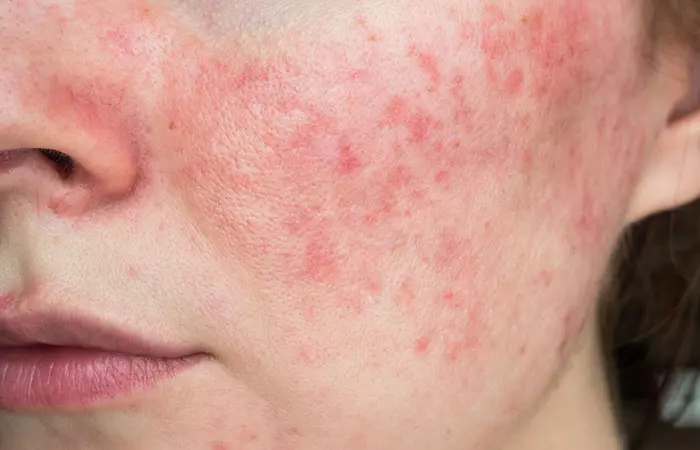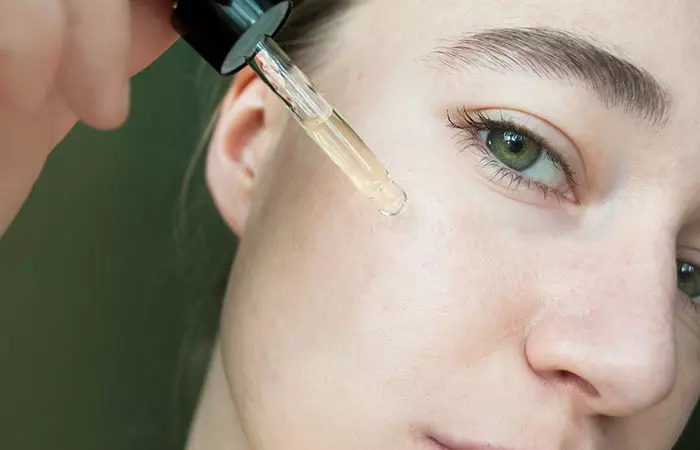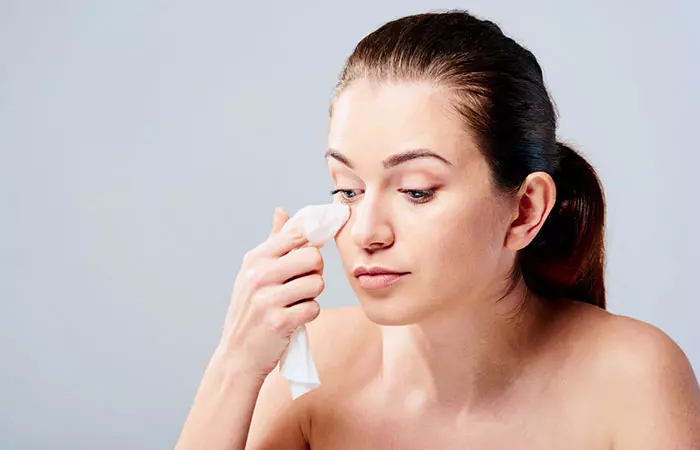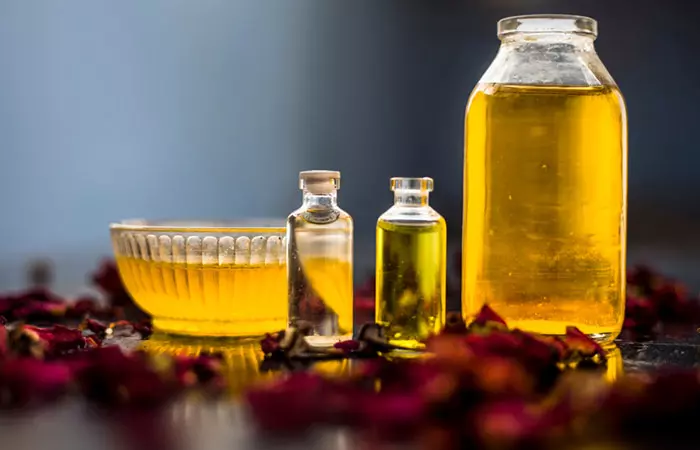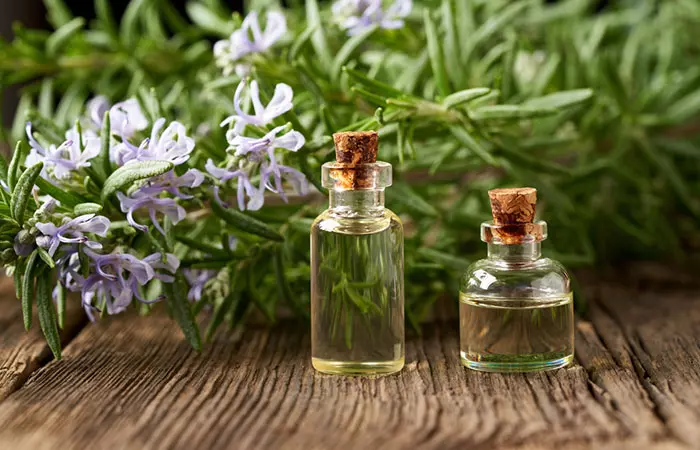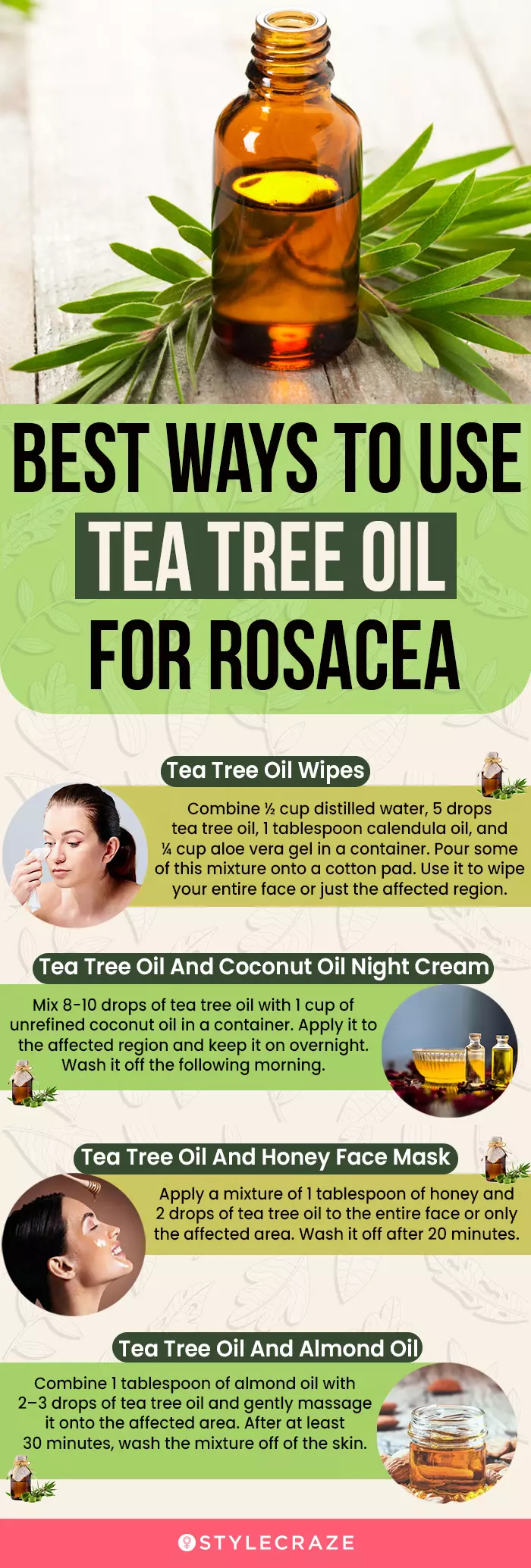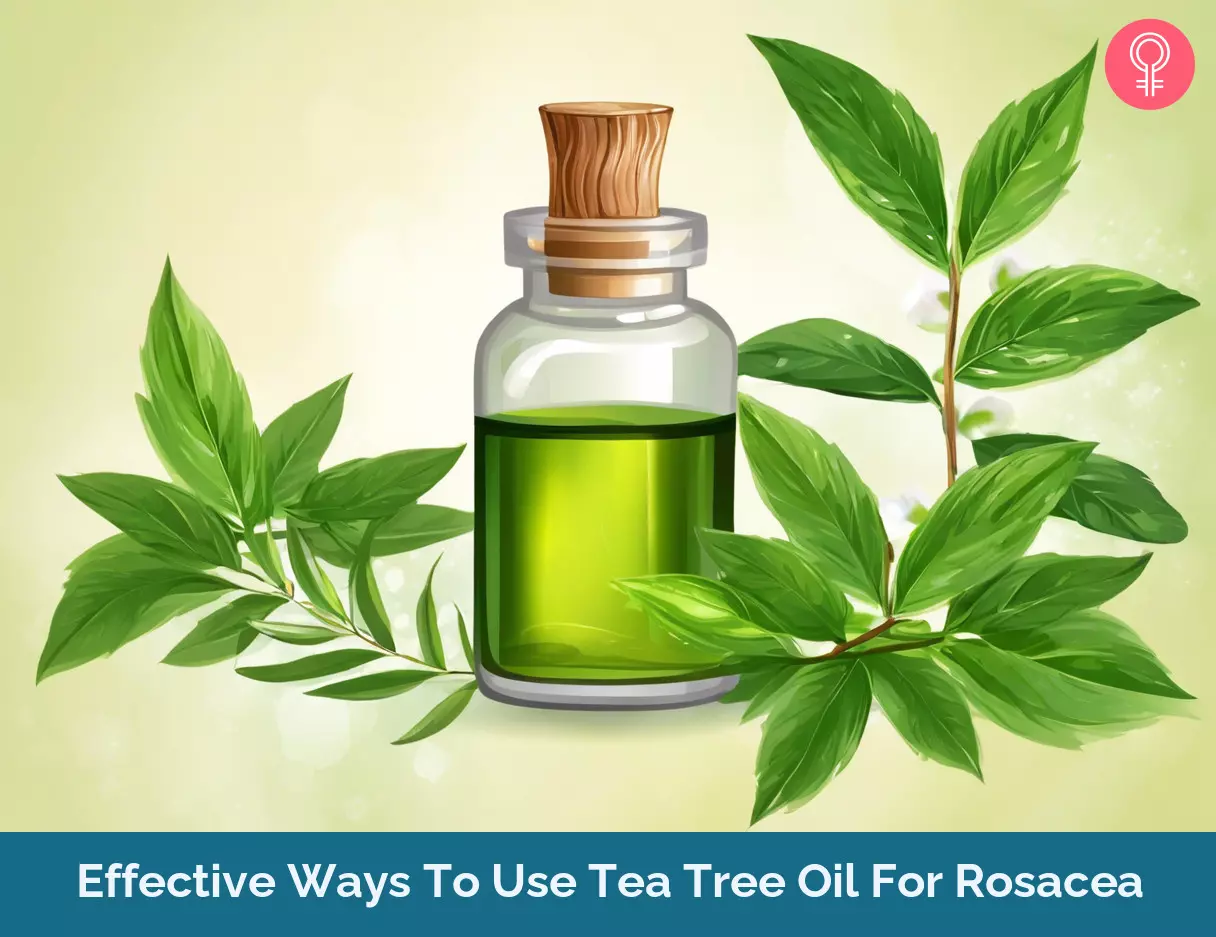Rosacea: The Condition And Its Symptoms
Rosacea is a skin condition that is marked by redness on the skin, especially on the face, usually on the nose and cheeks. It can spread to other parts of the face, including the eyelids. The American Academy of Dermatology Association says that those with the tendency to blush easily are vulnerable to this condition (1). According to a review, it was found that rosacea affects over 16 million patients in the US. It is even more prevalent in populations with Celtic heritage, like Ireland, where it affects up to 18% of the population. Globally, it’s estimated that over 5% of people have rosacea, and both males and females are affected equally. It is mainly caused and aggravated by factors that increase the flow of blood to your face. For instance, cosmetics, hot drinks, sun exposure, drugs (that dilate your blood vessels), and emotions may cause blushing. Anyone may develop this condition, but certain factors increase vulnerability, such as:
Fair skin Sun damage Age (people who are in their 30s are at risk) Smoking A family history of rosacea
The symptoms of rosacea include: This graph from a study published in Dermatology and Therapy shows symptoms of rosacea in 708 eligible respondents who were reported to have had four or more inflamed bumps or pimples. The most common symptoms were flushing (84.0%) and persistent facial erythema in the center of the face (69.1%), while persistent facial redness (69.2%), blushing or flushing (60.9%), and bumps or pimples (53.5%) were found to be the most bothersome.
Rosacea Symptoms
Redness around cheeks and nose (a persistent blush) Extremely sensitive skin that readily reacts to skincare products and sun exposure Swollen red bumps on the face or pimples Burning sensation on the face Rough and dry skin Enlarged pores Bulbous nose. This is more common in men than in women. The skin around the nose becomes thick and thus appears bulbous. Eye issues, such as irritation in the eyes, swollen eyelids (if the condition gets severe, it may spread to the eyelids as well), and dryness in the eyes.
Is Tea Tree Oil Good For Rosacea?
Yes, because it helps control and eliminates Demodex mites (2). Demodex is a genus of mites that live in our skin. There are two species, namely Demodex folliculorum (that lives in hair follicles), and Demodex brevis (that lives in our sebaceous glands). Demodex folliculorum is usually found in large numbers on the skin of people suffering from rosacea. Another study found that tea tree oil contains terpinen-4-ol, an ingredient that can kill Demodex mites (3). A study evaluated the efficacy of permethrin 2.5% along with tea tree oil gel on rosacea. The researchers found that the topical gel reduced the number of Demodex mites significantly and inhibited the inflammation caused by rosacea (4). Dalen, a YouTuber, shares a skin care tip for managing rosacea. The tip involves using a rollerball with a mixture of jojoba oil and tea tree oil to combat skin mites on the face, which are believed to contribute to rosacea symptoms. Of her own experience of the mixture, she states, “I do it twice a day, I do it morning and night. I wear it under my makeup, it’s really made a big difference in my skin (i).” There hasn’t been much research on the effectiveness of tea tree oil in controlling rosacea (caused by any reason other than excess Demodex activity). Still, it has helped treat similar skin issues.
How To Use Tea Tree Oil For Rosacea – 12 Natural Treatments
1. Tea Tree Oil Wipes
½ cup distilled water 5 drops tea tree oil 1 tablespoon calendula oil ¼ cup aloe vera gel Cotton pads
Tea tree oil is anti-inflammatory. It calms down the inflammation and promotes healing (5).
2. Tea Tree Oil And Coconut Oil Night Cream
1 cup unrefined coconut oil (do not melt the coconut oil) 8-10 drops tea tree oil
Like tea tree oil, coconut oil also has anti-inflammatory properties (6). It moisturizes the skin and soothes irritation.
3. Tea Tree And Lavender Essential Oils
8 drops of tea tree oil 8 drops of lavender oil ½ cup jojoba oil
Both tea tree oil and lavender oil have antibacterial properties (3), (7). Lavender oil is extremely gentle on the skin. This remedy helps soothe the skin and moisturize it without causing further irritation.
4. Tea Tree Oil And Olive Oil Face Cream
1 tablespoon olive oil 1 tablespoon rose water ½ tablespoon hazelnut oil ¾ tablespoons shea butter 2 tablespoons beeswax 40 drops tea tree essential oil
Shea butter has anti-inflammatory properties (8). Thus, it can reduce the irritation and redness caused by rosacea. Rosewater and beeswax soothe the skin (9).
5. Tea Tree Oil And Honey Face Mask
1 tablespoon honey 2 drops tea tree oil
Honey has antibacterial properties (10). Both tea tree oil and honey ease irritation, kill bacteria and soothe itchiness and rashes.
6. Tea Tree Oil And Apple Cider Vinegar
4 drops tea tree oil 1 tablespoon apple cider vinegar 100 grams aloe vera gel 2 drops castor oil 2 drops rose geranium oil
Apple cider vinegar is said to help maintain the pH balance of the skin, though there is no scientific proof of the same. Rose geranium oil has anti-inflammatory properties that can help in soothing skin irritation (11).
7. Tea Tree Oil And Almond Oil
1 tablespoon almond oil 2-3 drops tea tree oil
Almond oil is said to have anti-inflammatory properties. It can also moisturize the skin (12). Therefore, it may help in reducing a rosacea flare-up.
8. Tea Tree Oil And Jojoba Oil
1 tablespoon jojoba oil 2-3 drops tea tree oil 2 drops argan oil
Jojoba oil has a proven anti-inflammatory effect, and argan oil can soften and relax the skin (8). Thus, in combination with tea tree oil, these oils may help in the treatment of a rosacea flare-up.
9. Tea Tree Oil And Oatmeal
¼ cup oatmeal ¾ cup of coconut oil (unrefined) 1 tablespoon olive oil 3 drops tea tree oil
This mixture of oils and oatmeal has anti-inflammatory benefits (8), (13). It helps in reducing the inflammation and redness caused by rosacea.
10. Tea Tree Oil Moisturizer
Your favorite moisturizer 2-3 drops tea tree oil (per 30 ml of moisturizer)
This mixture helps in eliminating the mites causing rosacea and moisturizing your skin (4).
11. Castor Oil And Tea Tree Oil
1 tablespoon castor oil 2-3 drops of tea tree oil Clean washcloth
Castor oil works as an excellent skin-conditioning agent (14). Thus, it may help soothe the skin and relieve any discomfort caused by rosacea.
12. Tea Tree Oil Steam Treatment
You Will Need
2-3 drops of tea tree oil A bowl of hot water Clean towel
What You Have To Do Why This Works The hot steam helps open the pores and allows the tea tree oil to penetrate the skin. Its anti-inflammatory properties may help soothe the inflammation caused by rosacea (5). Let us make one thing clear: do not expect tea tree oil to cure rosacea. This condition is not curable, and you can only control the flare-ups. Also, before using anything on your skin, consult a doctor. Using essential oils on your skin can be a bit tricky. They work wonders for some and may not work at all for others. So, before you apply tea tree oil to your skin, consider these points.
Things To Consider Before Using Tea Tree Oil On Your Skin
If you have sensitive skin, find out some other alternative as tea tree oil may cause skin irritation. If you experience a burning sensation or it hurts at the site of application, wash it off immediately. In case you are taking any oral medication or using any ointment for treating your condition, consult the dermatologist before applying tea tree oil, as you cannot use certain topical medicines along with tea tree oil. Always dilute the tea tree oil with a carrier oil or another ingredient. Do not use it directly on your face. Never swallow tea tree oil. It is meant for topical application and not for consumption.
How to dilute tea tree oil for rosacea? Mix 2-3 drops of tea tree oil with a tablespoon of any carrier oil to dilute it. What is the best carrier oil to mix with tea tree oil for rosacea? Olive, jojoba, castor, sweet almond, and coconut oils are some good carrier oils to mix with tea tree oil for rosacea. What can you not mix with tea tree oil? Tea tree oil generally mixes well with skincare ingredients. However, it is not recommended to mix tea tree oil with retinoids, benzoyl peroxide, and other acne-fighting ingredients as it may irritate your skin. Can you reverse rosacea? No cure for rosacea has been developed yet. However, you can manage the symptoms of rosacea and prevent flare-ups by making lifestyle and dietary changes like consuming more prebiotics, probiotics, and fiber-rich foods, avoiding alcohol, excluding spicy and histamine-rich foods from meals, and lowering stress.
Illustration: Effective Ways To Use Tea Tree Oil For Rosacea
Discover how to effectively reduce redness and irritation from rosacea with these powerful essential oils. Reclaim your healthy, glowing skin by watching the video below.
